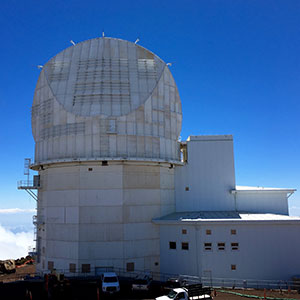

NSF's newest telescope to play critical role in better understanding sun, space weather
NSF's Daniel K. Inouye Solar Telescope moves closer and closer to completing its construction, with the upcoming milestone to be its "first light" image. This first photograph will reveal unprecedented detail of the sun's surface and serves as a preview for the world-class science to come from this preeminent 4-meter solar telescope. NSF's Inouye Solar Telescope will enable a new era of solar science and a leap forward in our understanding of our sun and its impacts on our planet.
No longer will solar astronomers and heliophysicists need to wait for a total solar eclipse to study the sun's corona, which is where we know solar activity begins that has impacts here on Earth.
The Inouye Solar Telescope can see the sun in greater detail than ever before and will play a critical role in advancing the study of the sun, including space weather. Space weather is a term used for magnetic eruptions from the sun that can damage satellites and trip power grids, causing long-lasting blackouts and disabling technologies like GPS. NSF's new ground-based Inouye Solar Telescope will work with space-based solar observation tools such as NASA's Parker Solar Probe and the European Space Agency/NASA Solar Orbiter. Together the three tools will, for the first time, expand the frontiers of solar research and improve our ability to predict space weather.
Built by NSF's National Solar Observatory and managed by the Association of Universities for Astronomy (AURA), the Inouye Solar Telescope combines a 13-foot (4-meter) mirror -- the world's largest for a solar telescope -- with unparalleled viewing conditions near the top of Haleakalā, Maui's largest volcano, to create conditions for unprecedented observation of the sun's surface. The telescope also uses state-of-the-art technology to compensate for blurring created by Earth's atmosphere known as adaptive optics.
VIDEOS
To download videos, push play and click on the arrow icon 
The Inouye Solar Telescope can resolve features as small as 30km on the surface of the sun. Compared to the previous publicly funded telescope -- the NSF's Dunn Solar Telescope -- which can resolve features 160km across, this is more than five times better resolution. The left hand image is the first image from the Inouye Solar Telescope. The right hand image simulates what the Dunn Solar Telescope would observe if pointing at the same spot on the Sun. For full image use policies please visit nso.edu/about/image-use-policy
The Daniel K. Inouye Solar Telescope has produced the highest resolution observations of the sun's surface ever taken. In this movie, taken at a wavelength of 705 nanometers (nm) over a period of 10 minutes, we can see features as small as 30km (18 miles) in size for the first time ever. The movie shows the turbulent, "boiling" gas that covers the entire sun. The cell-like structures -- each about the size of Texas -- are the signature of violent motions that transport heat from the inside of the sun to its surface. Hot solar material (plasma) rises in the bright centers of "cells,"" cools off and then sinks below the surface in dark lanes in a process known as convection. In these dark lanes we can also see the tiny, bright markers of magnetic fields. Never before seen to this clarity, these bright specks are thought to channel energy up into the outer layers of the solar atmosphere called the corona. These bright spots may be at the core of why the solar corona is more than a million degrees. For full image use policies please visit nso.edu/about/image-use-policy
RELATED NEWS
- NSF's newest solar telescope produces first images (NSF News Release, January 29, 2020)
- Primary mirror delivered to Daniel K. Inouye Solar Telescope (NSF News Release, August 3, 2017)
- National Solar Observatory's Daniel K. Inouye Solar Telescope On Track to Provide Ground-Breaking Observations of the Sun (NSO News Release, June 1, 2016)
- Senator Daniel Inouye remembered in telescope naming ceremony (NSF News Release, December 16, 2013)
RESOURCES
Any opinions, findings, conclusions or recommendations presented in this material are only those of the presenter grantee/researcher, author, or agency employee; and do not necessarily reflect the views of the National Science Foundation.
